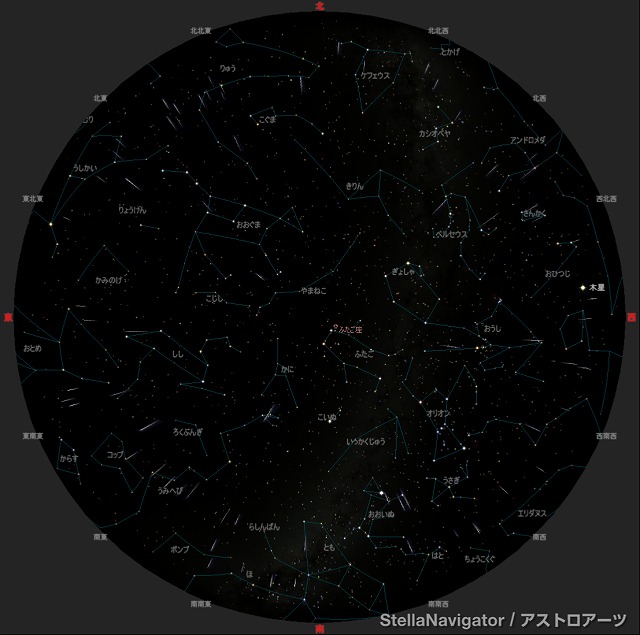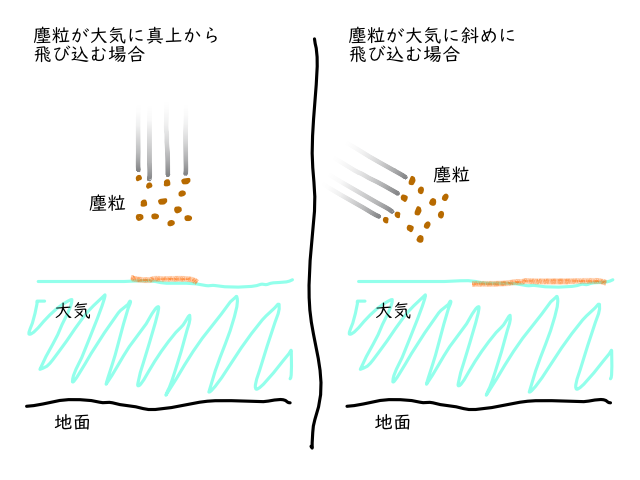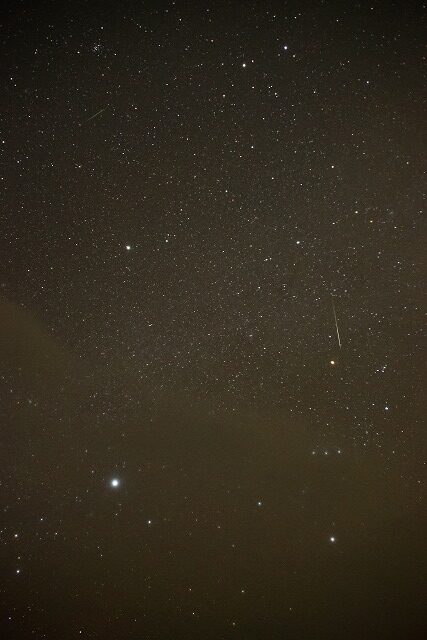(Machine translation by DeepL + adjustments by Gyegyopon, Translated article written for Japan without major changes, Sorry some Japanese language is still there)
Hello, this is Gyegyopon.
The Geminids meteor shower, which is active in mid-December, is one of the “three major meteor showers” and you can see many meteors every year without any outliers.
If you go to a place with a good view of stars, you can see a lot of meteors, and you may be able to see quite a few meteors even in the bright sky of a city.
This article summarizes the status of the Geminids meteor shower in 2023 and information about meteors.
I hope this article will be helpful for those who want to see meteors or learn more about meteors.
Main text
If you want to know the status of this year’s Geminids meteor shower quickly, please read “Summary“.
The “What is the Geminids meteor shower?” and following sections explain the contents of the “Summary” in a little more detail.
If you want to know more about meteors, please continue reading “What is a meteor?“
Summary
The Geminids meteor shower in 2023 will be visible under very good conditions because the time of the maximum is very close to the time when it is easy to see in Japan and there will be no influence of moonlight.
The Geminids meteor shower in 2023 will be best viewed on any (or all) of the three nights from the night of December 13 through the morning of December 16, with the greatest number of meteors expected to be visible after midnight on December 14 (and before dawn on December 15). If you are in a dark sky with a good view of the stars, you may be able to see as many as 70 meteors per hour at the most.
On all nights, the number of meteors is expected to increase around 9:00 p.m., with the greatest number of meteors after midnight.
Don’t worry about where in the sky you look. Meteors can appear in many different directions.
The best place to watch meteor showers is where the sky is dark (you can usually see many stars) and you have a wide view of the sky. It is best to stay as far away from large towns as possible.
What is the Geminids meteor shower?
The Geminids meteor shower is a meteor shower that is active every year in mid-December. The Geminids meteor shower is one of the three major meteor showers. The other two are the Quadrantids meteor shower in January and the Perseids meteor shower in August.
The Geminids meteor shower is relatively easy to watch because of the large number of meteors that appear consistently each year1 and the fact that they are visible not too late in the day.
However, the fact that they are active during very cold weather may make it a little more difficult.
This year’s Geminids meteor shower
The Geminids meteor shower in 2023 is expected to reach its maximum2 around 4:00 a.m.3 on December 15. Since the Geminids meteor shower is easily visible in Japan around 2:00 p.m., the time of the maximum this year is very close to the time when it is easy to see, so the conditions are favorable.
Moreover, the new moon will be on December 13 in 2023. The Geminids meteor shower will reach its maximum very close to the new moon, so you don’t have to worry about the moon’s influence at all.
Because of the good time of the maximum and the absence of the moon’s influence, the Geminids meteor shower can be observed under excellent conditions in 2023.
The greatest number of meteors will be visible on the night of December 14-15.
You will also be able to see more meteors on the nights before and after that, on the nights of the 13th and 15th, although not as many as on the night of the 14th.
Meteors of the Geminids meteor shower (this does not depend on the year) begin to appear when the sky becomes dark, gradually increase in number around 9:00 p.m., and tend to be most numerous after midnight. If you can, try to watch after midnight to see more meteors, but you may also try to watch earlier in the night without strain.
It is estimated that about 70 meteors per hour may be visible at muximum hours if the sky is enough dark.
Meteor Directions
Meteors can appear in various directions in the sky. Despite the name “Geminids meteor shower,” meteors do not appear only in the direction of the constellation Gemini.
Meteors in meteor showers have a characteristic way of appearing.
They radiate outward from a point in the night sky called the “radiant point”. It is called the “Geminids” meteor shower because the radiant point is located near the constellation of Gemini.
Meteors that appear near the radiant point are moving toward us, so their paths are short and they appear to move slowly. Meteors that appear some distance away from the radiant point are seen moving sideways, so their paths appear to be long and fast.

If you find a meteor in the night sky and it is moving outward from the Geminids’ radiant point, it is very likely to be a Geminid meteor4.
On the other hand, meteors moving in the other direction are not Geminids meteors, even if it is the active period of the Geminids meteor shower5.
How to observe meteors
To see many meteors, try to watch them in a place where the sky is dark (usually you can see many stars). If the sky is bright, faint meteors will be obscured by the brightness of the sky, and the number of visible meteors will be reduced.
As for where the “dark sky” is, roughly speaking, the further you are from a large city, the darker the sky will be. Because there is a lot of artificial light in a large town, they illuminate the sky and make it brighter.
Even when observing in the vicinity, it is best to find a place with as few lights nearby as possible.
It is also important to have a wide view of the sky. Meteors appear in various places in the sky, so if you have a wide view of the sky, the probability of meteors appearing there will increase.
You do not need any special tools to observe meteors. Observe with the naked eye.
If you use binoculars or a telescope, you will have a very narrow field of view, which is not good for catching meteors that may appear anywhere.
It takes time for your eyes to get used to the darkness. It is best to allow your eyes to adjust to the dark for about 15 minutes after you go to a dark place. During that time, try not to look at anything bright, such as a smartphone screen.
It is very tiring to stand and stare at the sky for a long time.
It is easier to observe the sky if you lie down on a leisure sheet or something similar. (Try your best to sleep during the day so you don’t fall asleep.)
Since you will be outdoors, you will feel very cold. It may be a good idea to protect yourself from the cold to the point of overdoing it. Using a fireplace or a sleeping bag is also a good idea.
Do not overdo it.
Also, make sure to observe rules and manners, as shouting at night or going into places you are not allowed can cause trouble. Be careful of accidents, as you will be working in the dark.
What is a meteor?
Let me explain a little more about meteors.
A meteor is a phenomenon in which dust particles, like grains of sand flying through space, fly into the earth’s atmosphere at high speed and shine.
Generally, meteors in meteor showers are based on dust grains ejected from comets. However, the Geminids meteor shower is an exception; the source of the dust grains is thought to be an asteroid called Phaethon (3200 Phaethon), not a comet. (The source is called the “parent body.”) Dust particles ejected from the parent body are spread over the entire orbit of the parent body, and when the Earth passes through the orbit of the parent body each year, the dust particles fly into the Earth’s atmosphere6.
This is why the same meteor shower appears at the same time each year.
Because all the dust particles come from the same direction, the meteors appear to the observer as if they radiate from a certain point. The central point from which the meteors radiate is called the “radiant point.” The radiant point is conceptual (thought up in the mind), so if you concentrate to look at the night sky, you will not see anything there.
If a meteor happens to appear at the radiant point, it appears as if light appears and disappears without moving. Such a meteor is called a “stationary meteor (stop meteor).” A stationary meteor is a meteor that comes straight toward you.
Number of visible meteors
The number of meteors you can see is related to the activity of the meteor shower itself, the altitude of the radiant point and the brightness of the sky at the place where you observe.
Activity of the meteor shower itself
Dust grains spread over the comet’s orbit have dense and sparse parts. If the earth flies into the dense part, many dust grains will fly into the atmosphere and many meteors will appear.
The increase in the number of dust grains entering the atmosphere and the increase in the number of meteors appearing is expressed as “increased activity of meteor showers”.
Roughly speaking, dust grains encircle the orbit of a comet in a cylindrical shape, with the dust grains becoming denser toward the center. Therefore, when the earth approaches the center of the dust grains, the activity of the meteor shower becomes more active, reaching a maximum at the densest part, and after the maximum, the dust grains gradually become sparser and the activity of the meteor shower calms down.
Altitude of the radiant point
If the activity of the meteor shower is the same, the higher the altitude of the radiant point, the more meteors will appear.
The reason why the number of meteors in the Geminids meteor shower tends to increase around 9:00 p.m. and become most numerous after midnight is that the altitude of the radiant point is highest after midnight.
One of the reasons why the number of meteors increases as the altitude of the radiant point rises is due to the difference in the range over which the same number of dust grains fly into the atmosphere.
Let us compare the case where the same number of dust particles come from directly above and the case where they come from an angle. When the dust particles come at an angle, the same number of dust particles are spread over a larger area. Therefore, fewer meteors are visible7.

Meteors do not appear when the radiant point is below the horizon8.
Sky Brightness
The more stars you see in the sky (dark sky), the more meteors you will see. On the other hand, in a sky with only a few stars (bright sky), the number of visible meteors will be smaller because the dark meteors will not be visible.
In addition to differences in sky brightness due to location and other factors, the moon also affects the brightness of the sky.
When the moon is very thin, it has little effect, but the thicker the moon is, the brighter it becomes. The sky is brightest at the time of the full moon, and the sky illuminated by the full moon is so bright that only very bright meteors can be seen.
In the case of the Geminids meteor shower, the number of visible meteors is more than two and a half times greater when observed in a sky where stars up to one magnitude fainter are visible9.
Parent Objects of the Geminid Meteor Shower (added on December 12, 2023)
Most of the parent bodies of meteor showers are comets. Comets are a mixture of ice and stones (dust grains), often called “dirty snowballs”. When a comet approaches the sun, the ice sublimates into gas and the dust grains are ejected along with it. The dust grains then fly into the Earth’s atmosphere and become meteors. Asteroids, on the other hand, are made of stone or iron and do not emit dust grains.
The parent body of the Geminids meteor shower is thought to be Phaethon. Phaethon was discovered as an asteroid in 1983.
Since Phaethon’s orbit coincides with that of the dust grains in the Geminids meteor shower, it was speculated that Phaethon might be the parent body of the Geminids meteor shower. Since Phaethon, an asteroid, did not emit dust grains, it was thought that perhaps it had emitted dust grains as a comet in the past, but had stopped doing so now for some reason, such as ice depletion.
In 2009, NASA’s Solar Observatory “STEREO” observed a short tail around perihelion (the closest point to the sun in its orbit), suggesting that Phaethon is still active as a comet, although its activity level is low.
In 2018, however, observations by NASA’s “Parker Solar Probe” observatory indicated that the amount of material Phaethon can eject is too small to be the source of the Geminids meteor shower. In 2022, observations by the Solar Observation Orbiter “SOHO” revealed that the Phaethon’s tail is made up of sodium gas, not dust grains.
So, how are the dust grains that form the Geminids meteor shower supplied? To solve this mystery, JAXA is planning to launch the “DESTINY+” spacecraft, which will approach Phaethon at a distance of about 500 km over the next two years. In the short time the two spacecrafts fly by, it will photograph the surface of Phaethon and analyze the surrounding dust grains.
DESTINY+ was scheduled to be launched in FY2024, but due to delays in rocket development, the launch date has been postponed to FY2025.
Related Information
Reference
- National Astronomical Observatory of Japan: Geminids meteor shower will reach its maximum (December 2023)
- IMO (International Meteor Organization): 2023 Meteor Calendar (see Luminosity Ratio)
- NAOJ/Asahi Shimbun: Subaru Telescope Live Camera
- Shigeo Uchiyama: Calculation method of the total number of visual observations of meteors (see the difference in the number of meteors depending on the altitude of the radiant point)
- National Astronomical Observatory of Japan: Calculation of Almanac (You can find out the time of moonrise and sunrise in each area)
- JAXA:
- NASA: Asteroid’s Comet-Like Tail Is Not Made of Dust, Solar Observatories Reveal
- Saitama Shimbun: Launch of Destiny spacecraft postponed
Others
Change History
(December 12, 2023) Added links related to “Parent Objects of the Geminid Meteor Shower”.
脚注
- The Perseid meteor shower is also stable. The Quadrantid meteor shower can be hit or miss depending on the year.
- “Maximum” means that a meteor shower is the most active and its time.
- The Geminids meteor shower usually reaches its normal maximum around 262.2 degrees ecliptic solar longitude each year. Although the name “solar ecliptic longitude” refers to the “sun…,” it is best to think of it as referring to the position of the earth as it orbits the sun. It is an angular measure of how much the earth has moved from a specific location, the vernal equinox, around the sun by its orbit.
- It is possible that meteors that do not happen to be in the Geminids meteor shower will move in a similar direction, so this is not a 100% reliable way to identify them.
In order to identify meteors with certainty, we observe meteors from two or more points and determine the three-dimensional path and speed of the meteors using the principle of triangulation. If the original dust particle has the same orbit as the mother comet, we can determine that it is a meteor from that meteor shower. - Meteors that do not belong to a particular meteor shower are called “scattered meteors.”
- Therefore, only celestial objects whose orbits intersect with the Earth can be the parent bodies of meteor showers.
- If the altitude of the radiant point is θ degrees, the area over which the same number of dust grains fly into the sky is (1/sin θ) times larger than when the radiant point is at the zenith (directly above the head).
This means that, for example, if the altitude of the radiant point is 30 degrees, the area of the atmosphere over which the same number of dust particles can fly into is twice as large, and thus the number of meteors is halved. (The right-hand side of Fig. 2 shows the radiant point at an altitude of 30 degrees.) - When the radiant point is just below the horizon, meteors may appear, although they are very few in number.
- The luminosity ratio is a numerical expression of how many times more meteors are visible in the sky where stars up to one magnitude fainter are visible. For example, suppose you observe a meteor shower with a magnitude ratio of 2, and you see 10 meteors in the sky where you can see stars up to magnitude 3 (the faintest stars). If you observe a meteor shower in a sky in which you can see the stars up to magnitude 4, you would expect to see 10 x 2 = 20 meteors. 10 x 2 x 2 x 2 = 80 meteors in a sky in which you can see the stars up to magnitude 6.
The magnitude ratio of the Geminids meteor shower is 2.6.


